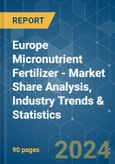Key Highlights
- Largest Segment by Type - Zinc : Wide spread of alkaline and calcareous soils in the region and growing staples like maize, wheat in large area demanding the more zinc micronutrient fertilizers.
- Fastest growing segment by Type - Boron : The more sandy soils with acidic PH in the region are more suceptable to boron deficiency and high concentration of calcareous soils also affects boron availability in soils
- Largest Segment by Crop Type - Field Crops : The domination of field crops in Europe Fertilizers market is mainly due to its large cultivation area in the region. They account for more than 95% of total crop area.
- Largest segment by Country - Russia : Need for high productivity on the available land to meet the growing demand for food which is attributed to growing population.It accounts for about 4.46% of Europe crop area.
Europe Micronutrient Fertilizer Market Trends
Zinc is the largest segment by Product.
- In the Rest of Europe, countries that consume the majority of fertilizers include Poland, Belgium, and Southeastern European countries, accounting for 51.98% of the value of Europe's micronutrient fertilizer market. The share is anticipated to record a CAGR of 3.2% during the forecast period.
- By form, the specialty micronutrient market was the largest in 2021, accounting for 55.07%. It is majorly applied on field crops, with a share of about 96.12%. With increased technological and scientific advancements, specialty fertilizer applications are primarily used for field crops. The conventional fertilizer micronutrient market accounted for 44.92%. It is majorly applied on field crops, with a share of about 96.50%.
- By nutrient type, zinc dominated the micronutrient fertilizers market in the region, accounting for 42.01% in 2021, followed by copper at 24.68% and iron at 15.51%. Similarly, micronutrient fertilizers are mostly applied through foliar application in the region, accounting for 66.17% in 2021, followed by fertigation at 33.82%.
- Micronutrient deficiency in plants and soil has been steadily increasing. It has become a major cause of concern in the European Union. As a result, factors such as depleting soil health, steadily increasing area under high-value crops, and the requirement for higher productivity, as well as improved awareness about advanced fertilizers and their increasing adoption, may drive the regional market for micronutrient fertilizers during the forecast period.
Russia is the largest segment by Country.
- The micronutrient fertilizer market in Russia is the largest market in the European region, with an expected share of 14% and a market value of USD 109.9 million in 2022, projected to reach USD 136.8 million by 2028 due to the rising population and the need for higher agricultural productivity.
- The micronutrient fertilizer market in Ukraine accounted for a 7% share of the European micronutrient fertilizer market and was valued at USD 56.5 million in 2021, with a volume consumption of 17.4-kilo metric ton in the same year. The market has been witnessing constant growth in the recent past, even during the COVID-19 pandemic.
- France is the third-largest market for micronutrient fertilizers in Europe, with an estimated market value of USD 121.9 million in 2022, accounting for a share of 6.0% of the European micronutrient market due to the increasing area under cultivation of horticulture crops, which increased from 1.2 million hectare in 2017 to 1.3 million hectare in 2021, which is further expected to increase in future.
- The effect of heatwaves in Europe, coupled with the energy crisis, may impact the micronutrient fertilizer consumption in the region. However, the market is anticipated to grow moving forward as Europe has many large farmers who adopted industrial farming, with efficiency being the key motive. These farmers have a higher adoption rate for advanced technology and fertilizers, leading to increased adoption of micronutrient fertilizers.
- Therefore, factors like degrading soil health, an increase in area under highly valued crop cultivation, the need for higher productivity, increasing knowledge about advanced fertilizers, and the increased availability of fertilizers are expected to drive the European micronutrient fertilizer market during the forecast period.
Europe Micronutrient Fertilizer Industry Overview
The Europe Micronutrient Fertilizer Market is fairly consolidated, with the top five companies occupying 87.12%. The major players in this market are Fertiberia, Kingenta Ecological Engineering Group Co., Ltd., Sociedad Quimica y Minera de Chile SA, Valagro and Yara International ASA (sorted alphabetically).Additional Benefits:
- The market estimate (ME) sheet in Excel format
- 3 months of analyst support
Table of Contents
Companies Mentioned (Partial List)
A selection of companies mentioned in this report includes, but is not limited to:
- AGLUKON Spezialduenger GmbH & Co.
- Compo Expert GmbH
- Fertiberia
- Haifa Group Ltd
- Kingenta Ecological Engineering Group Co., Ltd.
- Sociedad Quimica y Minera de Chile SA
- Trade Corporation International
- Valagro
- Verdesian Life Sciences .
- Yara International ASA
Methodology

LOADING...










